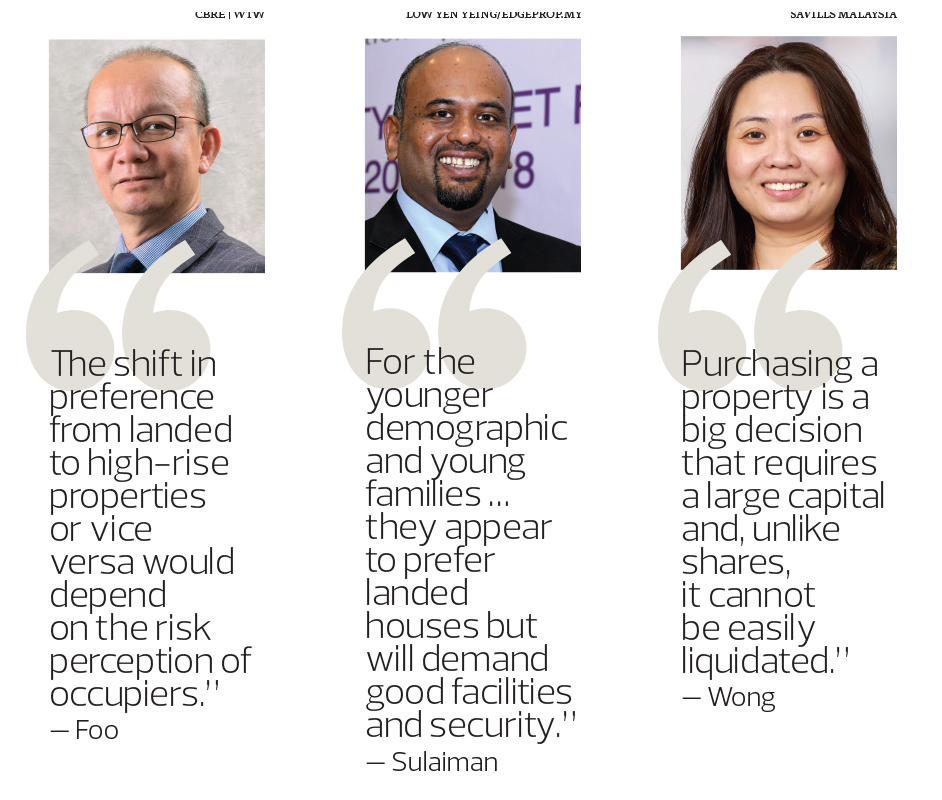
This article first appeared in City & Country, The Edge Malaysia Weekly on February 8, 2021 - February 14, 2021
Apart from having a massive economic and environmental impact, the Covid-19 pandemic has radically changed people’s lives. Many have had to adapt to the new normal and living through lockdowns. This has led to homes becoming much more than just a space to live in.
City & Country conducted a survey at the end of last year to find out whether the Movement Control Order (MCO) has had an effect on homebuyers’ preferences — for example, the size and location of the property — when it came to their next purchase. The results were published in our Nov 23 issue.
In this issue, we are revisiting the results of the same survey and taking a closer look at whether buyer preferences have shifted from landed to high-rise properties, the factors that affect their housing choices, and whether they would be more open to renting rather than buying houses post-MCO.
A total of 327 respondents took part in the survey, categorised into four groups, with the largest comprising those between the ages of 31 and 40 (41.1%), followed by the 22 to 30 (26.4%), 41 to 50 (23.9%) and 51 and above (8.6%) age groups.
Most of the respondents were single (46.2%) while 40.6% were married with children and 13.2% were married without children. About 36.7% of them were living with a partner or spouse and children while 27.2% were staying with their parents. The rest were either living with a partner or spouse (18%), alone (10.1%), or with housemates (8%).
Most of the respondents were living in terraced houses (37.9%) or condominiums (25.1%), with the rest in semi-detached houses (11.3%), bungalows (9.8%), apartments (7%), serviced apartments (5.8%), townhouses (2.8%) or co-living (0.3%).
As for their preferred accommodation should they decide to move in the future, 34% chose condominiums and 28.1% selected terraced houses. This was followed by semidees (13.1%), bungalows (9.8%), serviced apartments (8.2%), apartments (4.2%), townhouses (2.3%) and co-living (0.3%).
“The shift in preference from landed to high-rise properties or vice versa would depend on the risk perception of occupiers. Buyers who prefer to live in high-rises view them as having stricter access control, which is a boon for health and safety enhancement. Living in a self-sufficient mixed-use development may also be more convenient amid recurring lockdowns,” says CBRE | WTW managing director Foo Gee Jen.
Given the economic challenges resulting from the pandemic, housing affordability would also play a part in the decisions of home seekers, he adds. “Between landed and high-rise properties, the current market trend suggests that there is more rigidity in the base price and rental rate of the former while the latter’s base price and rental rate are wider in range, usually determined by unit size and features.”
According to Rahim & Co International Sdn Bhd director of research Sulaiman Saheh, while landed properties may provide more space and privacy and fewer restrictions compared with communal living, high-rise developments offer better security services, swimming pools and landscaped gardens, which usually come with a monthly maintenance cost that is higher than that of most landed schemes, except for landed strata developments that may be more comparable.
He notes that the shift in buyers’ preference from landed to high-rise properties usually involves moving from non-stratified or non-gated landed houses to stratified high-rise properties. This can be seen among first-time, independent dwelling upgraders, young families and an emerging group of empty nesters.
“For the younger demographic and young families that wish to upgrade from their existing landed houses in older but non-gated communities — although some may be guarded, managed by their residents’ association — they appear to prefer landed houses but will demand good facilities and security.
“Thus, the ideal properties are typically gated-and-guarded developments that are usually costly, especially if situated in urban areas. In this case, condominiums and serviced apartments would be the alternative as they are relatively cheaper. They would serve the needs of buyers and tenants with their desired facilities and expected level of safety and security,” says Sulaiman.
Determinants and demands
Foo says buyers’ profile and lifestyle are key determinants of their housing preferences. “Bachelors and young working adults are likely to prioritise convenience more than the older generations, who place more value on the space provided by landed properties. Hence, the former may prefer mixed-use or transit-oriented developments or choose a smaller unit in order to live in the city centre.”
As a family matures, more space for other requirements would be required. Sulaiman opines that buyers’ housing preferences depend on the composition and attributes of the household.
He says singletons may still have the freedom to move around and be less domesticated while a couple with children and toddlers may have more family activities and routines at home. The demands of a teenager would differ from those of a toddler, and the requirements of a young professional would be different from those of a senior executive. Families with an elderly relative at home would have different demands too.
“For instance, the empty nesters’ segment, aged 50 and above, will see their children getting married and moving out to form new households. Their current landed homes will become underutilised with empty rooms. This group will want to rescale their home and opt for a stratified or high-rise property that offers the necessary space and facilities to suit their needs,” explains Sulaiman.
Foo notes that security and access control would be important criteria to consider as well. “Furthermore, property management and maintenance have been the common concerns when it comes to high-rise properties, which in turn raises questions about sustainability and long-term living. Hence, it is important for homebuyers to assess the management capability of each stratified development.
“The revised Strata Titles Act and Strata Management Act 2013 are more comprehensive, with the practices and duties of the developer, management body and owners outlined. There are also more detailed provisions on the preliminary management and formation of a management corporation, common property and by-laws in the Third Schedule — for instance, prohibition of rental for short-term accommodation is now enforceable to safeguard the interest of residents.”
To rent or to buy
The survey results show that 77.27% of those in the 22 to 30 age group would prefer to buy a property, while 22.73% would prefer to rent one. A similar trend was observed in the other age groups, with a far larger percentage preferring to buy rather than rent — 87.13% of those between 31 and 40 years old; 92.59% in the 41 to 50 age group; and 90% of those aged 51 years and above.
Savills Malaysia Sdn Bhd director of research and consultancy Amy Wong says some may opt to rent as they believe it affords them a debt-free lifestyle. “The rental rate in Malaysia is relatively cheaper than mortgage payments. For most residences in major cities, the achievable rent would not be able to cover the mortgage instalments and monthly maintenance charges of strata properties.”
She notes that renting is a great option for millennials, who have embraced the sharing and gig economy with all its flexibility and do not want to be tied down to a mortgage. “Purchasing a property is a big decision that requires a large capital and, unlike shares, it cannot be easily liquidated. However, those with young families might consider owning a good property as an investment, as this would allow them to enjoy capital appreciation and cash out in the future for education or retirement purposes.”
Meanwhile, Rahim & Co’s Sulaiman says housing affordability remains a challenge in the market, thus more people have chosen to rent while building up their savings. Developers and financial institutions have also been promoting rent-to-own (RTO) schemes, which have spurred rental activities.
“However, there is a small group of genuine renters who have no intention of buying a home anytime soon. They are the global or nomadic workforce who prefer the flexibility of moving around between jobs or outstation/overseas postings,” he adds.
While a slowdown in property purchases is expected in the near term, CBRE | WTW’s Foo does not foresee a broad paradigm shift. “The sentimental and real value attached to owning a property will continue to drive residential purchases among Malaysians, as long as it is within their means. On the bright side, the ongoing corrections in prices and rental rates could help the residential market regain its attractiveness when the dust settles.”
Save by subscribing to us for your print and/or digital copy.
P/S: The Edge is also available on Apple's App Store and Android's Google Play.


